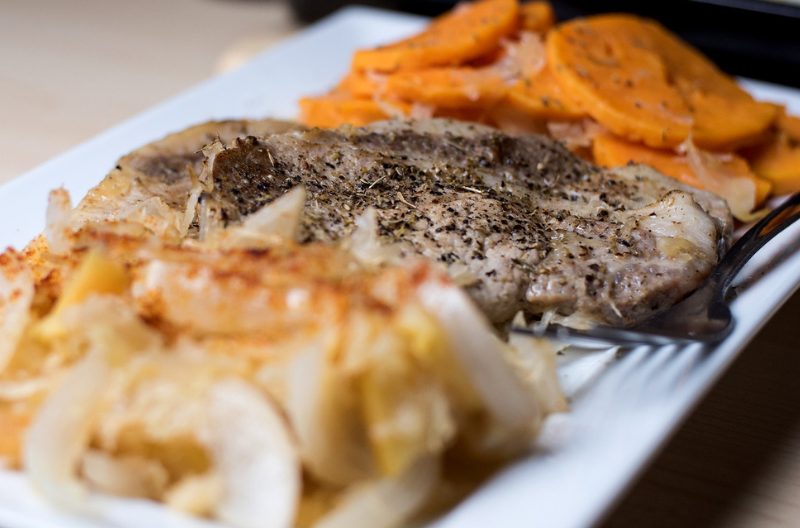Feeling a little adventurous in the kitchen? Learning to cook hearty meals is all about experimentation and being open to new recipes. You might have heard about sauerkraut before, but do you realize how good for you it is? This side dish is packed with super healthy probiotics, which means that you have to try it for yourself. As an added bonus, it just so happens to taste absolutely delicious! With that all in mind, let’s take a look at what this dish is, why its so healthy, and how to make your own.
What is Sauerkraut?
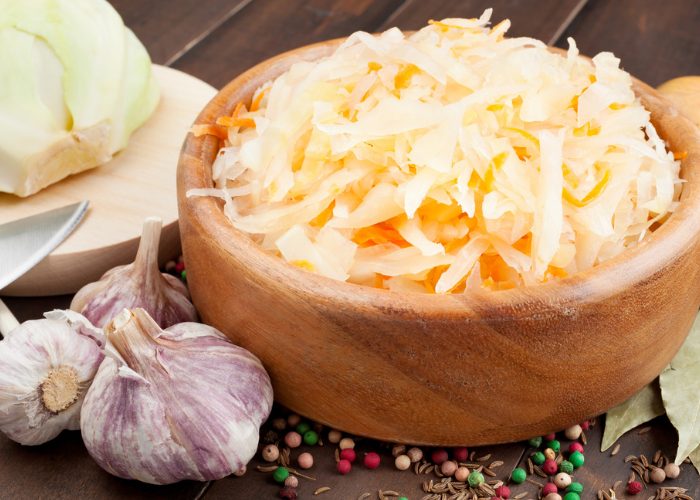
Far from a modern food fad, sauerkraut is actually thought to date way back to the Roman Empire era.[1] During the cooler months, fresh food would be hard to come by. For that reason, the ancient people were forced to rely on forms of preserved produce.
One such dish was fermented cabbage, or sauerkraut. Experts believe that this particular meal became so popular thanks to its nutrition-rich makeup and its inviting savory flavors.
While, over the years, the common recipe may have shifted, the basics of how to make sauerkraut remain the same. Most often associated with Germany, where the dish gets its name, the modern form of this fermented food is now eaten all over the globe.
In fact, some experts believe that it has been a popular part of the American diet since the country was first founded.[2] Of course, you can now get both commercial and artisanal versions of the product in stores around the US.
How is it fermented?
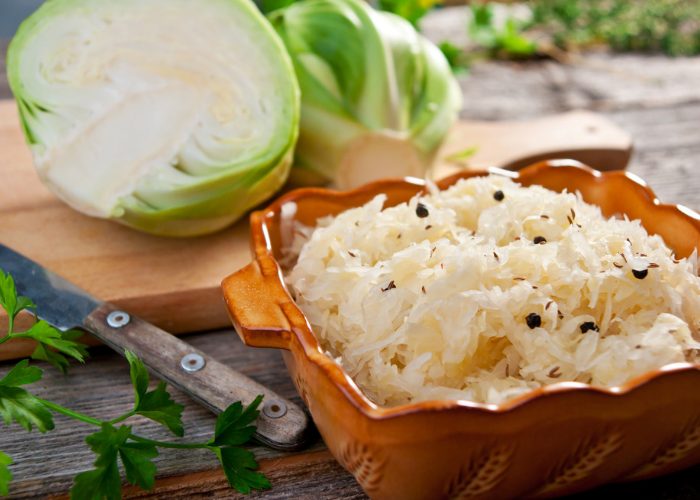
You only need two ingredients to make a basic sauerkraut recipe – salt and cabbage. When you combine these two things, the fermentation process begins and the concoction starts to make both carbon dioxide and acid. In turn, this lowers the environmental pH levels, which stops any harmful bacteria from growing that may ruin the cabbage.[3] That means that the finished product is entirely safe to eat and extremely healthy too.
The fermentation process should take place at around 64 degrees Fahrenheit and takes around a month to complete. The healthy organisms that are produced after this can support your gut bacteria and give the dish its appealing smell and taste. The dish also has a unique texture that many people absolutely love when they try it.
How to cook sauerkraut
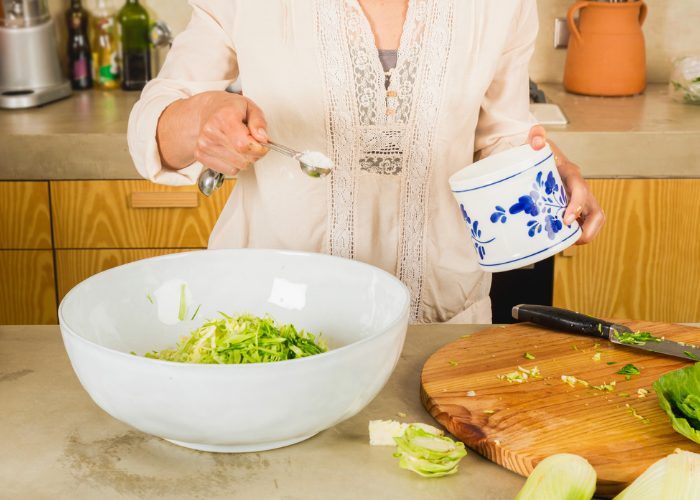
One of the reasons that many people choose to opt for store-bought sauerkraut, rather than making their own, is that they believe it’s a difficult feat. Nothing could be further from the truth. You don’t need any professional equipment to create this dish for yourself.
The home sauerkraut fermentation process is strikingly simple. All you need to do is shred some cabbage and then combine it with salt. Next, you should massage the mixture and pack it into an air-tight container.
Then, you leave the cabbage for at least five days (but up to a month, if you can manage it!) and wait for the magic to happen. You can keep this stuff in a jar and use it as a handy, yet nutritious side dish for pretty much any meal you may have in mind. Delicious!
Is it Good For You?
Believe the hype. There’s been a lot of excitement surrounding fermented foods recently and there’s a good reason for that fact. The fermentation process of sauerkraut actually creates healthful probiotics, which you can also find in other foods like yogurt.[4] Including sources of probiotics in your everyday diet could yield some rather remarkable results.
So, is it really that good for you? The short answer is yes, but there’s a myriad of reasons. For one thing, these forms of bacteria support your health by allowing you to gain more nutrients from the food that you eat.[5] Plus, consuming these probiotic-rich foods could also help to restore the balance of bacteria in your gut, which is extremely important.[6] With that in mind, let’s take a look at some health benefits you should know about.
Helps boost your digestion
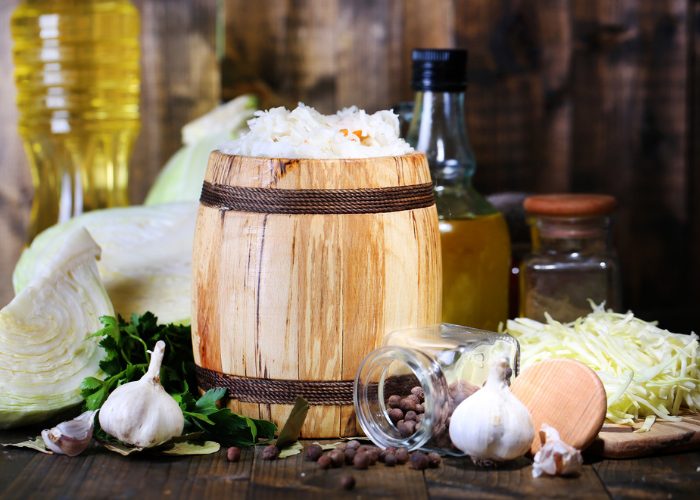
Are you battling some serious digestion problems? Around 70,000,000 people in the US struggle with some form of
Eating fermented foods, such as sauerkraut, could be the answer to some of these irritating health problems. Research shows that medical experts have previously used probiotic-rich products to help prevent and cure digestive problems.[8] Since these issues are so prevalent, it stands to reason that more of the population should learn a simple sauerkraut recipe and start adding the side to some of their meals.
Aside from that, one of the most impressive benefits is that it manages to tackle some of the side effects of these conditions. Studies have suggested that consuming probiotics could help to lessen flatulence (gas), bloating, and other signs of digestive issues.[9] That can only be positive. Should you find that you’re suffering from any of the above, trying a little sauerkraut can help to ease the situation in the long-run.
Contributes to a healthy heart
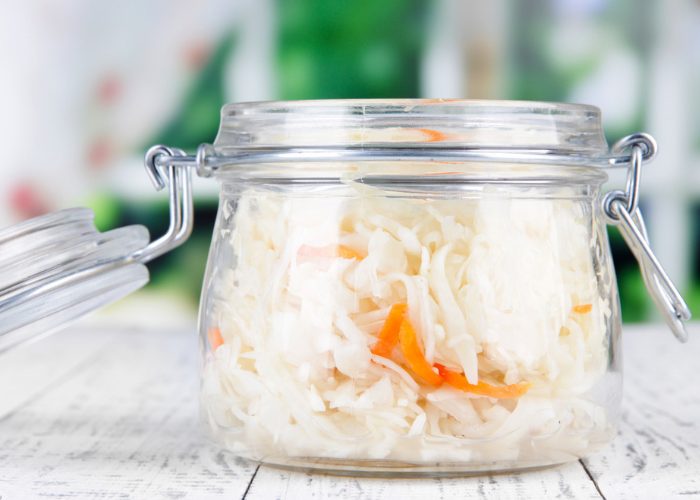
Heart disease is one of the biggest killers in America. One in four deaths in the country is a direct result of this fatal health condition, according to the Centers for Disease and Prevention.[10] While there are many different forms of heart condition, the deadliest is coronary heart disease, which kills over 370,000 people each and every year.[11] Looking after your cardiovascular health is an essential way to protect yourself as you age.
Fiber and probiotics are an immensely healthy combination, especially when it comes to your cardiovascular wellness. There’s a whole host of sauerkraut benefits that can be directly linked to these two aspects of the dish. Research has previously suggested that including a decent dose of probiotics in your diet could help to lower your blood pressure over an extended period.[12] Since high blood pressure increases your risk of heart-related conditions, doing what you can to lower it is crucial.
Soluble dietary fiber, which is found in abundance in any sauerkraut recipe, is also linked to cholesterol-lowering properties.[13] Living with high-cholesterol can increase your chances of having either a heart attack or a stroke, both of which could be fatal. With that in mind, simply eating some sauerkraut and other probiotic-rich foods could be the answer.
Could help you to lose weight
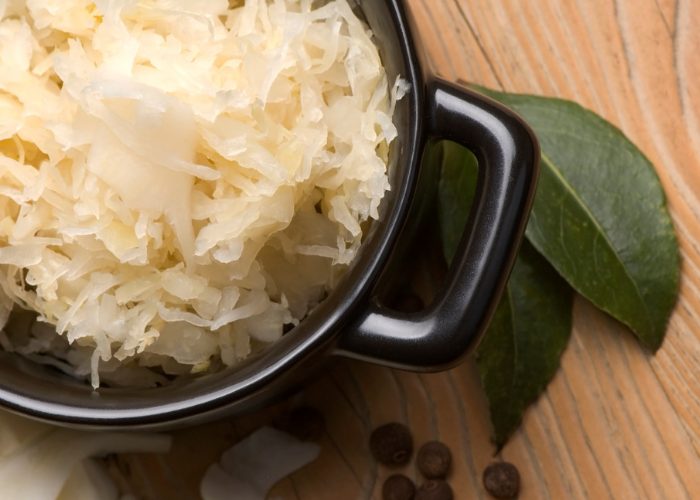
Are you currently starting your weight-loss journey? Trying to shed those pounds can feel like an uphill battle, at the best of times. While exercising regularly and using portion control is the baseline for any weight-loss program, there are some handy dietary hacks you can enlist as well. One such tip could be to include sauerkraut in your everyday meals.
When you look at a basic sauerkraut recipe, you will notice that there’s not a whole load of ingredients in there. Cabbage is the main item in this particular dish. Needless to say, cabbage is high in both vitamins and fiber. Eating fiber-rich foods can help you to stay fuller for longer, meaning that you won’t be as tempted to snack on high-fat foods. Research shows that high-fiber foods keep you sated for much longer than alternatives.[14]
But that’s not the only reason that eating this tasty dish may be smart move when you’re trying to get into shape. The probiotic makeup of this type of food means that you may absorb less fat from the food that you eat on a regular basis. Right now, even experts are somewhat baffled by this phenomenon. However, studies have suggested that the more probiotics you consume, the more fat your body actually excretes (rather than storing!).[15]
May decrease stress levels
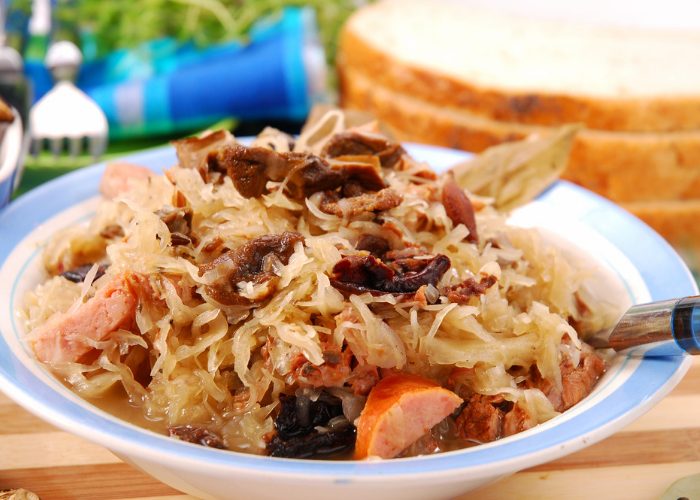
Stress may seem like a minor ailment but that’s simply not the case. Whether it’s workplace-related stress or any other form of this mental condition, doing what you can to decrease stress is an important part of your health and wellness regime. Stress has previously been linked to poor cardiovascular health and a higher risk of mortality.[16]
Taking care of your mental well-being should be at the top of your priority list. While it’s important to make various lifestyle changes to support your mental wellbeing, you should also consider how your diet impacts the way that you feel on an emotional level as well.
There’s a great deal to explore in this area, but initial studies suggest that having healthy microbes in your gut, as a result of consuming probiotics, could have a positive effect on your mental health.[17] Specifically, research suggests that the inclusion of gut-healthy probiotics in the diet could help to diminish feelings of anxiety, depression, and stress.[18]
Common Questions You May Have
Ready to add some fermented sauerkraut to your diet? Before we explore some recipe ideas, let’s take a look at some of the questions that you may still be pondering. If you’re entirely new to this type of food, it’s natural that you may want to get a little extra information about it. Here are some frequently asked questions and, of course, answers!
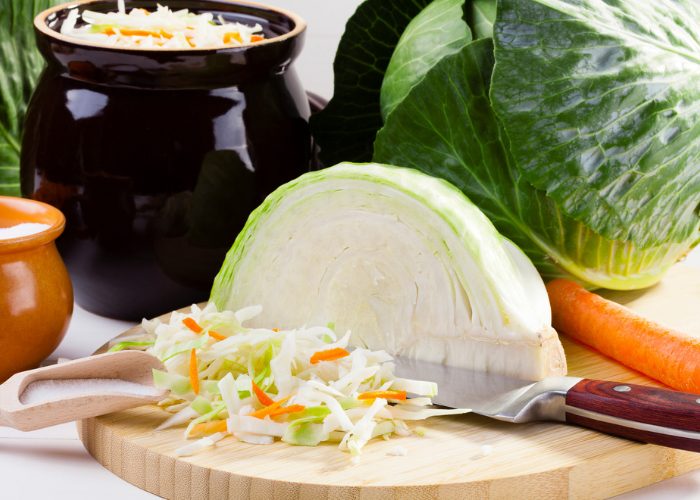
FAQ 1: How expensive is sauerkraut to make?
It certainly sounds like a premium product, which is why so many people believe it costs a lot to make. However, in truth, it’s a very affordable side dish that you can make on a low budget.
The two main ingredients here are cabbage and salt. You can add vinegar, but you don’t always have to. Should you want to keep it strikingly simple, you don’t need to add anything else into the mix. The fermentation process happens naturally, which means you don’t need any pricey extras.
FAQ 2: Is sauerkraut good for you?
Sauerkraut can be eaten as part of a healthy and balanced diet. The most recent evidence suggests that there may also be a range of significant benefits that affect your health. For example, studies suggest that it may decrease your risk of heart problems, help you to lose weight, and support your gut bacteria. Plus, the probiotic properties of this food means that making and eating this dish is well worthwhile.
All of the above suggests that this side dish is one of the healthiest, not to mention delicious things you can add to your daily diet. However, moderation is key, which means that you shouldn’t eat an excess of this food. Ensure that you take that into account.
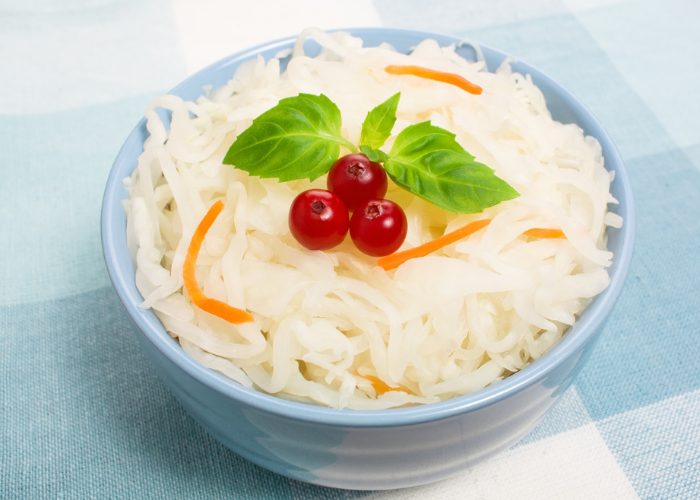
FAQ 3: How long does it last?
Since you only need a small portion of the stuff with each meal, it could take you quite some time to finish it off completely. Don’t panic. When you store this type of food correctly – sealed in a fridge – you should find that it lasts around six months.
Note that batches will vary and the sauerkraut recipe you use will play a role in this as well. It’s important that you keep an eye on the side dish to make sure that it’s still safe to eat. If you notice a major change in its smell, texture,or composition, the chances are that it has begun to go rotten. In that case, you need to throw it out.
FAQ 4: How much sauerkraut should you eat?
Before you get carried away and start eating huge piles of the stuff at every sitting, there’s something you should keep in mind. Any sauerkraut recipe has one disadvantage – it’s quite high in sodium, i.e. salt content.
Experts state that eating a diet that is high in salt can lead to high blood pressure and may even put your health at serious risk.[19] For that reason, you should make sure that you only consume a little at a time. For example, you might find that a tablespoon full of the stuff is enough to add a flavorsome extra to your meal. When you’re giving yourself a portion of the side, be careful not to overdo it.
How to Make Sauerkraut: 4 Recipes
Now, let’s get cooking! First of all, we’ll take a look at a basic sauerkraut recipe that you can get started on right away. Then, we will take a look at three other recipes that use the main one within them. That means that once you’ve created yours from scratch, you can get started on learning how to add it and use it in different dishes. Needless to say, this side dish is remarkably versatile and works well in many meal types.
1. Basic Sauerkraut Recipe
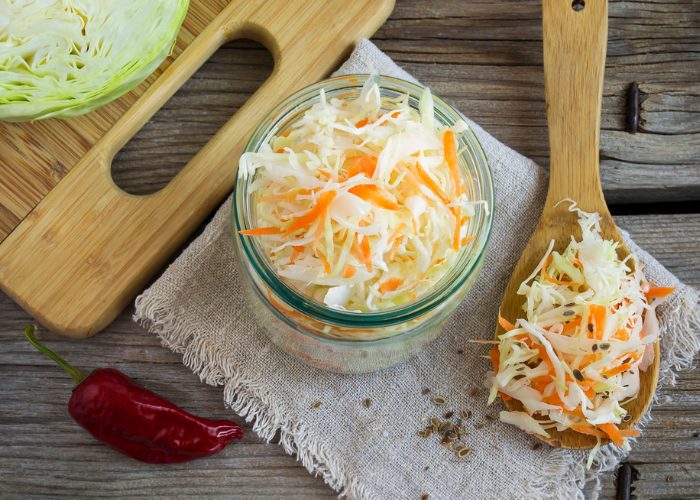
Let’s start at the very beginning. If you’re wondering how to make a simple sauerkraut recipe, you’ve come to the right place. Before we look at some more complicated options (and ways in which you can use this side dish), it’s worth going through the standard recipe. This one should be your go-to recipe when you’re short on time but high on enthusiasm. Here’s what you should know.
Prep Time: 15 minutes | Serves: 10 | Calories per serving: 28 kcal
Equipment: Large knife, chopping board, large mixing bowl, wooden spoon, medium mason jar, and freezer bag
Ingredients
- 900g firm white cabbage
- 2 tsp sea salt
Directions
- First, thoroughly wash the cabbage. Then, use the knife to take out the heart of the cabbage and start to slice it finely. The finer you can get each piece of cabbage, the better the recipe will work.
- Next, put the cabbage slices in a large mixing bowl and add the sea salt into the mix. Make sure that you wash your hands well. Then, start to massage the cabbage as roughly as possible. Continue this motion for around five minutes.
- When you start to see a brine coming out of the cabbage, you know that the process is working. Carry on massaging the mixture until the cabbage starts to wilt and change form.
- As soon as you are confident that the cabbage has wilted, you need to start packing it. Get a medium mason jar and ensure that it’s clean. Start with a small portion of the cabbage and put it at the bottom of the jar. Use the wooden spoon to pack it downward.
- You should notice that the brine begins to appear above the top of the cabbage. When you see that, add some more cabbage to the jar and repeat the same action. Remember, the brine should always be above the cabbage in the jar.
- Finally, put the freezer bag in the top of the jar and spread it out so that it keeps any air out of the container. This is an extra precaution as the brine should protect the cabbage.
- Seal the mason jar and put it in the fridge. Leave the sauerkraut for at least five days before you try it for yourself. If possible, you should leave it for a month or more.
Pro Tip: Make sure that the cabbage is never above the brine in the jar. Exposure to oxygen could mean that harmful types of bacteria start to form in the container. This is dangerous for your health so it’s something that you want to avoid at all costs. Be sure to push the cabbage down and keep an eye on the brine levels at all times. You can also add some vinegar should you want to as well. It’s up to you!
2. Pork and Apple Sauerkraut Bake
Looking for an unbelievably tasty pork and sauerkraut recipe to try making for yourself? We might have just the thing. Finding a meal idea that the whole family will adore can often be quite difficult. However, this next dish is sure to give everybody just what they need. Packed with temptingly rich and indulgent flavors, you’ll certainly want seconds. You can use the basic recipe above for this one and then follow these directions!
Prep Time: 25 minutes | Cook Time: 1 hour | Serves: 4 | Calories per serving: 525 kcal
Equipment: Large baking tray, tin foil, large skillet, spatula/tongs, medium pot, small bowl, and spoon
Ingredients
- 4 medium pork chops
- 500g peeled and sliced sweet potatoes
- 2 cups homemade sauerkraut
- 100g chopped apple (slices)
- 1 tsp chili powder
- 100g chopped white onion
- 1 tsp garlic powder
- 1 Tbsp olive oil
- Pepper
Directions
- Preheat the oven to 350 °F. Grease your baking tray with olive oil and pop it in the oven while you prepare the rest of the ingredients.
- Boil some water in the pot and place the sweet potato slices in there for five minutes or until soft. Drain the water and set the slices aside.
- Put the skillet on a medium high heat and add some oil to the pan. If the pork chops have a bone, remove it now. Add them to the skillet and season the pork chops with some pepper. Cook on each side for no longer than a minute or until browned. Leave to rest.
- In a small bowl, mix the sauerkraut, garlic powder, chili powder, apple slices, and onion slices.
- Get the tray out of the oven and start layering your bake. Create a layer of sweet potatoes at the bottom of the tray. Then, put a layer of the sauerkraut mixture on top.
- Add the browned pork chops on top of the sauerkraut mixture so that they are flat. Top with the last half of the sauerkraut.
- Cover the baking tray with some tin foil and then pop it in the oven. Cook for around one hour, checking the chops are no longer pink inside.
Pro Tip: Not sure about one of the ingredients in this recipe? There are plenty of swaps you can make that will work just as well. For example, if you don’t love sweet potatoes, you can switch them for pumpkin, butternut squash, or even regular white potatoes. Keep in mind that the cook-time may vary depending on the swaps you make.
3. Vegan Carrot and Sauerkraut Soup

There are few things in life as unashamedly satisfying as a warming soup. If you’re in the mood for this wholesome dish, why not whip one up for yourself? Doing so takes hardly any time and is oh-so-satisfying! What’s more, you’ll be pleased to know that this one is a 100% vegan recipe, which is great for your health, not to mention your waistline. Let’s find out how to make a carrot and sauerkraut soup that nobody can resist.
Prep Time: 15 minutes | Cook Time: 20 minutes | Serves: 5 | Calories per serving: 384 kcal
Equipment: 2 medium pots, spoon, handheld blender, and skillet
Ingredients
- 150g chopped onion
- 500g homemade sauerkraut
- 300g chopped carrots
- 1 Tbsp chopped cilantro
- 1 Tbsp oil
- 3 Tbsp passata
- 1 Tbsp wheat flour
- 500ml vegetable stock
- 2 Tbsp garlic powder
- 1 Tbsp paprika
- 200g canned butter beans
- 1 tsp olive oil
- Sea salt (to taste)
Directions
- Bring some water to the boil in a medium pot. Add the chopped carrots into the pot and leave for 20 minutes. While they are boiling, you can get on with the other steps.
- Heat some olive oil in the skillet on a medium heat. Put the onions in the pan and cook for around five minutes, or until they become soft and translucent.
- Add the garlic powder, paprika, and wheat flour into the pan. Stir well so that the onions, oil, and other ingredients combine to make a paste-like mixture.
- Next, move the mixture to another pot and put it on the heat. Add the passata and vegetable stock to the pot and stir. Leave to simmer for two minutes.
- Drain the carrots and test them to see if they are soft. If they are, use the handheld blender to blast them into a mash. Drain the butter beans.
- Add the carrot mash, homemade sauerkraut, and butter beans to the pot. Cover and leave to simmer for a further 10-20 minutes.
- Serve by adding a little sea salt to taste and garnishing with some chopped cilantro.
Pro Tip: If you’re not a fan of butter beans, don’t fret! They are merely an added extra in this warming sauerkraut recipe. Leave them out for a smoother, less chunky finish! Also, if you happen to have a penchant for all things hot, add a small pinch of chili powder to this recipe. You can even try making your own spice blend!
4. Sauerkraut-Rich Potato Salad
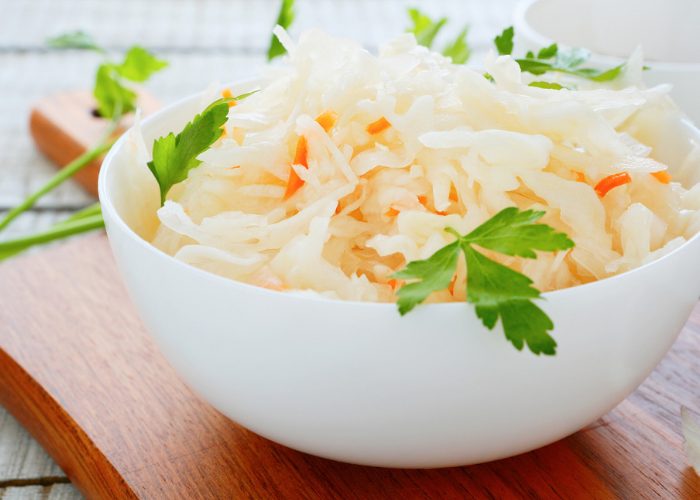
Whether you’re hosting an epic dinner party or merely having a meal with your loved ones, you should never over look the importance of side dishes. Of course, a classic side has to be the humble potato salad. Why not give this classic recipe a twist and add some probiotics into the mix? By using Greek yogurt (rather than salad cream), you can keep the calorie-count down. What’s more, the inclusion of the sauerkraut will give you a health boost too…
Prep Time: 20 minutes | Cool Time: 2 hours | Serves: 6 | Calories per serving: 172 kcal
Equipment: Medium pot, spoon, and large mixing bowl
Ingredients
- 500g chopped white potatoes
- 150g chopped onion
- 400g homemade sauerkraut
- 300ml Greek yogurt
- 100g chopped scallions
- 1 Tbsp paprika
- 1 Tbsp garlic powder
- Salt and pepper (to taste)
Directions
- Put some water in the pot and bring it to the boil. Wash and add the potatoes to the water. Leave to simmer for around 15 minutes or until soft. In the meantime, start making the coating for the potato salad.
- Take your homemade sauerkraut and drain it so that there is no brine left. Rinse well.
- In a large mixing bowl, combine the Greek yogurt, chopped onions, paprika, and garlic powder. Finally, add the drained sauerkraut and mix well.
- When the potatoes are cooked, drain them and leave them to cool down for around 5-10 minutes.
- Add the potatoes and mix well. You should make sure that the potatoes are thoroughly covered in the coating. Add the chopped scallions as a garnish.
- Cover the bowl and put it in the fridge for at least two hours before serving.
Pro Tip: Make sure that the brine is completely washed off the cabbage before you add it into the mix. The saltiness of this liquid could react with the Greek yogurt, which will mean that you end up with a big old mess. By draining your sauerkraut and starting over, you still get the sharp salty taste of it throughout the dish with none of the hassle.
3 Tips For Making Sauerkraut to Perfection
Now that you’ve got some wholesome sauerkraut recipe ideas, you may well be keen to get started. After all, there’s nothing more exciting than giving an entirely new recipe a shot when you have the time. Before you do so, though, here’s a little extra advice along the way. Keep these golden rules in mind when making sauerkraut for yourself.
1. Make sure that the cabbage is crisp and fresh
When you’re making any homemade version, the freshness of your ingredients is the most important thing. As you can see here, the standard recipe only includes two ingredients. Search for some white cabbage that is as crisp and fresh as possible. Perhaps the best way to ensure the highest possible quality of this is to go to the store on the day that you plan to make your own.
2. Keep all your tools as clean as possible
During the fermentation process, your sauerkraut recipe will gain some healthy forms of bacteria, known as probiotics. However, you don’t want anything else growing inside your mason jar. For that reason, it’s important that you do all you can to ensure that your tools are as clean as possible. Before you get started, it could be worth deep-cleaning everything that you plan on using with boiling water. Doing so will help you to kill any harmful bacteria that could be lying in wait there. (Oh and, of course, wash your hands!)
3. Don’t overdo it when it comes to salt!
Tempted to add more sea salt to the mix? Don’t you dare! Make sure that you follow the recipe exactly when making a sauerkraut recipe for the first time. If you put too much salt into it, you could find that you ruin the taste of the final product. As though that weren’t enough to hold you back, super high sodium levels are terrible for your health. The last thing you need is to have too much of the stuff! Be concise when measuring out your sea salt.
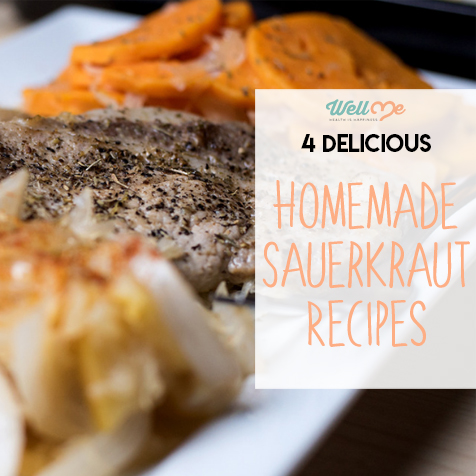
Conclusion
So, what are you waiting for? Adding a dose of sauerkraut to your meals could help to boost your health in a wide variety of ways. Plus, you will soon find that this salty little snack is thoroughly addictive for all the right reasons. Start cooking today and whip up a batch that you can use as part of some of your most well-loved recipes.
References
- [1] https://www.ncbi.nlm.nih.gov/pmc/articles/PMC5977097
- [2] https://www.ncbi.nlm.nih.gov/pmc/articles/PMC5977097
- [3] NCBI. https://www.ncbi.nlm.nih.gov/pmc/articles/PMC5977097
- [4] https://www.ncbi.nlm.nih.gov/pmc/articles/PMC4058509
- [5] https://www.ncbi.nlm.nih.gov/pubmed/6860621
- [6] NHS. https://www.nhs.uk/conditions/probiotics
- [7] http://americannutritionassociation.org/newsletter/digestive-issues
- [8] https://www.ncbi.nlm.nih.gov/pubmed/15481739
- [9] NCBI. https://www.ncbi.nlm.nih.gov/pubmed/23981066
- [10] https://www.cdc.gov/heartdisease/facts.htm
- [11] https://www.cdc.gov/heartdisease/facts.htm
- [12] NCBI. https://www.ncbi.nlm.nih.gov/pubmed/25047574
- [13] https://www.ncbi.nlm.nih.gov/pubmed/21776465
- [14] http://sro.sussex.ac.uk/51367
- [15] NCBI. https://www.ncbi.nlm.nih.gov/pubmed/25884980
- [16] https://www.ncbi.nlm.nih.gov/pmc/articles/PMC129630/?_escaped_fragment_=po=57.5000
- [17] https://www.ncbi.nlm.nih.gov/pubmed/23497650
- [18] NCBI. https://www.ncbi.nlm.nih.gov/pubmed/25879690
- [19] https://www.nhs.uk/live-well/eat-well/salt-nutrition

